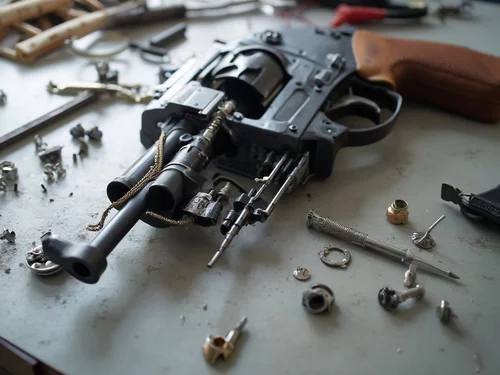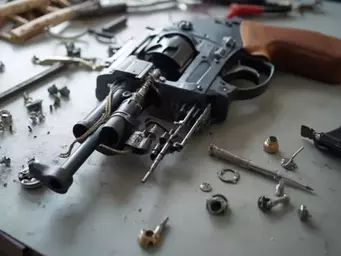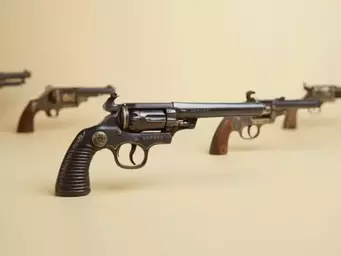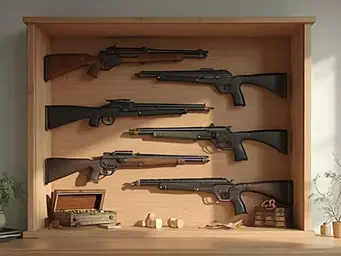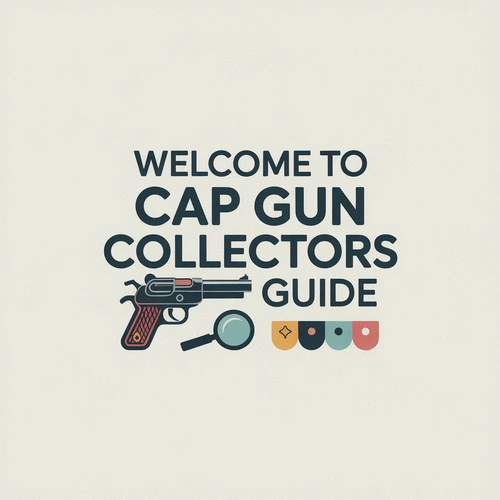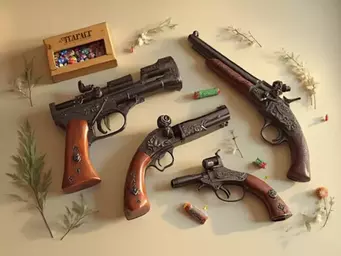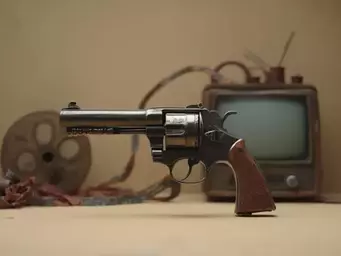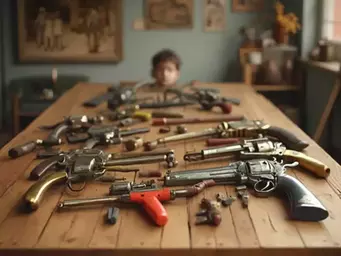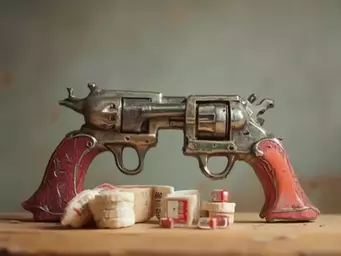As you venture into the fascinating world of cap guns, consider this: the maintenance of your collection can significantly enhance its longevity and value. Understanding the mechanisms and common issues is not just about preserving toys; it's about preserving memories and craftsmanship for future generations.
What You Will Learn
- Different types of cap guns include revolvers, automatic models, and lever-action designs, each with unique mechanisms.
- Common mechanical failures include trigger malfunctions, spring fatigue, and corrosion, which can affect performance.
- The evolution of cap guns reflects historical advancements, from metal designs to modern safety features.
- Regular inspections and timely repairs can prevent minor issues from escalating, preserving the collection's value.
- Engaging with the cap gun community provides access to resources for replacement parts, restoration tips, and fellow enthusiasts' insights.
Cap Gun Mechanisms & Common Issues
A visual guide to the types of cap guns, their common mechanical failures, and historical evolution.
Cap Gun Mechanisms
- •Revolvers
- •Automatic Models
- •Lever-Action Guns
Mechanical Failures
- •Trigger Malfunctions
- •Spring Fatigue
- •Corrosion
Historical Milestones
- •First Cap Guns (Metal)
- •Rise of Plastic Models
- •Modern Innovations
Repair Essentials
- •Regular Inspection
- •Address Minor Issues
- •Use Right Tools
Understanding Cap Gun Mechanisms and Their Common Issues
When diving into the world of cap guns, it's essential to understand the various mechanisms that power these delightful toys. Cap guns come in different styles, each utilizing unique mechanics that bring them to life. From spring-action designs to more intricate models, learning about these types can enhance your appreciation and maintenance efforts.
Some common types of cap guns include:
- Revolvers: Often found in classic designs, these feature rotating cylinders that hold multiple caps.
- Automatic models: These guns simulate rapid firing with a simple trigger pull, creating a thrilling experience.
- Lever-action guns: These require a manual lever pull to load and fire, giving a nostalgic feel to the action.
By familiarizing yourself with these types, you can better diagnose any issues that might arise during your collecting journey!
Identifying Common Mechanical Failures in Cap Guns
As a cap gun collector, knowing how to identify mechanical failures is crucial to preserving your collection. Common problems include misfiring, weak sounds, or even complete failure to fire. Often, these issues arise from wear and tear or improper maintenance.
Some typical mechanical failures to keep an eye out for are:
- Trigger malfunctions: The trigger may stick or not engage properly.
- Spring fatigue: Over time, springs can lose tension, affecting performance.
- Corrosion: Exposure to moisture can lead to rust, impacting functionality. For more information on corrosion and its effects, you can refer to the Corrosion Basics document.
Identifying these issues early on can save you time and effort in repairs, allowing you to keep your collection in prime condition!
Cap Gun History: Evolution of Design and Functionality
The history of cap guns is as colorful as the toys themselves. From their inception in the early 20th century to modern replicas, cap guns have evolved significantly. Understanding this evolution not only adds depth to your collecting but also highlights the craftsmanship behind these toys.
Key milestones in cap gun history include:
- The introduction of the first cap guns: These were often made of metal and designed to mimic real firearms closely.
- The rise of plastic models: As manufacturing changed, plastic became the go-to material for affordability and safety. The CPSC offers safety guidelines for toy guns, including those made of plastic.
- Modern innovations: Today's cap guns may include safety features and realistic sounds, appealing to new generations. You can learn more about firearm terminology, which can sometimes apply to realistic toy replicas, by consulting the NIJ's Firearms Examiner Training Glossary.
By appreciating the journey of cap guns, collectors can better understand their value and maintain the legacy of these iconic toys for future enthusiasts!
Engage with Fellow Collectors!
What has been your biggest challenge in maintaining your cap gun collection? Whether it's sourcing parts, dealing with repairs, or finding the perfect display solution, sharing your experiences can help others in the community. Let's start a conversation!
Frequently Asked Questions About Cap Guns
- What are the common types of cap guns?
- Cap guns typically come in revolver, automatic, and lever-action models, each with distinct firing mechanisms.
- What are common mechanical failures in cap guns?
- Common issues include trigger malfunctions, spring fatigue, and corrosion due to moisture exposure. Addressing these early can prevent further damage.
- How has cap gun design evolved over time?
- Cap guns have evolved from early metal designs to more modern plastic models. Contemporary designs often incorporate enhanced safety features and realistic sounds.
- Why is regular inspection important for cap guns?
- Regular inspection helps identify minor wear and tear before it escalates into major problems, preserving the cap gun's functionality and value.
- Where can I find replacement parts for cap guns?
- Replacement parts can often be found on online auction sites like eBay, specialized toy collector websites, or local antique shops.
- How can engaging with the cap gun community help me?
- Joining forums and groups allows you to access resources, share tips on repairs and restoration, and connect with other enthusiasts, enhancing your collecting experience.
Summing Up: Cap Gun Repair Essentials
As we wrap up our journey through the intricacies of cap gun repair, it's important to remember the essential practices that ensure our beloved toys not only last but also bring joy for generations to come. Proper maintenance and repair techniques can extend the life of your cap guns, allowing their history and craftsmanship to shine through. Let's recap some key takeaways to keep in mind!
Key Takeaways for Successful Cap Gun Maintenance
- Regularly inspect your cap guns for signs of wear and tear.
- Address minor issues before they develop into major problems.
- Use the right tools and techniques for disassembly and repair.
- Keep your collection clean and protected from corrosion.
- Stay informed about the latest restoration tips and community advice.
By following these guidelines, you can not only maintain the function of your cap guns but also enhance their value and appeal. Remember, a well-cared-for collection reflects your passion for this unique hobby!
Encouraging Safe and Responsible Repair Practices
Repairing cap guns can be a fun and rewarding endeavor, but it’s essential to do so safely and responsibly. Always remember to work in a well-lit area, and keep your workspace organized. This will help prevent losing small parts and ensure you can find everything you need as you go through the repair process.
Additionally, if you're ever in doubt about a repair, don't hesitate to reach out for advice. Connecting with fellow hobbyists can provide invaluable insights and encourage a culture of safety in the cap gun community. What's your best tip for ensuring safe repairs? I'd love to hear your thoughts!
Next Steps: Engaging with the Cap Gun Community
Now that you are equipped with essential repair knowledge, it’s time to dive deeper into the vibrant cap gun community. Engaging with fellow enthusiasts can enhance your experience and provide support as you continue your collecting journey.
Finding Replacement Parts and Resources Online
One of the first steps in engaging with the community is identifying sources for replacement parts. Various online shops and auction sites cater specifically to cap gun collectors, offering everything from vintage components to modern replicas. Here are a few resources to help you find what you need:
- eBay - A treasure trove of collectible items.
- Specialized toy websites - Many cater to vintage collectibles.
- Local antique shops - Great for hands-on hunting!
Joining Forums and Groups for Cap Gun Enthusiasts
Consider joining online forums or social media groups dedicated to cap gun collecting. These platforms can provide not just a sense of community but also a wealth of information about repairs, restoration, and even sharing your collection with others. Engaging in discussions can spark new ideas and give you access to tips you may not have considered before!
Exploring Cap Gun Collectors and Their Insights
Finally, don't overlook the value of connecting with seasoned collectors. Their stories and experiences can offer unique perspectives and strategies that enhance your own collecting journey. You might even find local collectors who host meet-ups or trading events! The cap gun community is a rich source of knowledge and camaraderie.
With these next steps, you'll not only grow your collection but also build lasting connections within the cap gun community. What connections have you made so far? Sharing your journey can inspire others and keep the passion for cap guns alive!
Recap of Key Points
Here is a quick recap of the important points discussed in the article:
- Understand the different types of cap gun mechanisms: revolvers, automatic models, and lever-action guns.
- Identify common mechanical failures: trigger malfunctions, spring fatigue, and corrosion.
- Acknowledge the historical evolution of cap guns, from metal to plastic models and modern innovations.
- Conduct regular inspections and address minor issues before they escalate.
- Utilize proper tools and techniques when repairing cap guns.
- Engage with the cap gun community for support and resources, including forums and local collectors.

